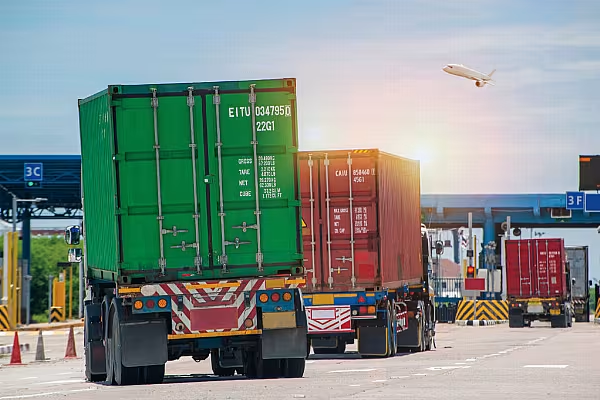Limited capacity in both air and sea freight is leading to increased shipping costs, not to mention delays. Should consumers do their Christmas shopping early? Nick Peksa reports. This article first appeared in ESM's September/October 2021 edition.
Since mid-April, the UK has been experiencing a transportation crisis, primarily driven by Brexit and the COVID-19 pandemic. Supermarkets and food manufacturers alike are bracing themselves for a prolonged period of disruptions and potential stock-outs.
Logistics UK, which represents freight owners, including retailers, has estimated a shortage of 90,000 HGV drivers. This number also includes the 25,000 or so drivers from the EU that have returned home since the UK formally left the bloc.
HGV driving test backlogs are exacerbating the problem, with an estimated 45,000 drivers waiting to obtain their licenses. With this in mind, UK retailers have started to offer substantial signing-on bonuses to recruit new drivers.
As we are all aware, this crisis is not just limited to the UK. The global freight industry is in crisis, with premiums being introduced to secure the transportation of goods.
Online Sales Are King
With global economies reopening, the EU GDP is forecast to grow by 4.8% in 2021 and 4.5% in 2022. This has primarily been driven by consumer and industrial confidence, and the appetite for consumer spending.
This global spending spree has resulted in an extremely low retail inventory-to-sales ratio for many retailers. US retailers experienced their lowest ratios in over 28 years, thus stimulating large volumes of imports, as both manufacturers and retailers replenished their COVID-depleted stocks. Stock shortages are also visible across the EU in a wide variety of categories, ranging from bicycles to propane to fresh produce – primarily those imported from further afield.
Container Shipping Breaking Records
We are now ten months into 2021, and container ship capacity is extremely limited. Order levels are sitting at a five-year high and accelerating. Securing capacity will continue to remain difficult in the near future, as only a limited number of new vessels are entering the market.
Global demand is forecast to outstrip container shipping capacity this year. Demand for container shipping is expected to increase by 5% to 7%, with capacity only growing by 4%. This supply imbalance will continue throughout 2022.
The supply-demand imbalance has fuelled the profitability of carriers. The operating profits of 11 of the major carriers reached $16.2 billion (€13.9 billion) in Q1 2021. Christmas has come early for container shipping, as Q2 profits are expected to eclipse Q1.
To put this into context: Q1 profits are greater than the sum of the previous first ten quarters combined. These profits are being reinvested into refurbishing the fleet, and the long-term outlook indicates a return to a healthier-sized fleet. This added capacity could lead to an oversupply in 2023.
Shipping To Europe
Demand is so strong and capacity so limited that carriers have introduced premiums as high as $2,500 (€2,100) per container, to guarantee space. Importers with annual contracts are moving some containers at contracted prices. The uncertainty caused by the pandemic has resulted in 90% of cargo being moved at premium rates. This has resulted in the average spot price for containers increasing by a staggering 358% year on year.
The highest increase has been on the record-breaking Shanghai-to-Rotterdam route, standing at an annual increase of 636%, primarily driven by cargo owners bidding up rates to secure passage for their goods. The good news is that we might have seen the peak of this market.
Potential For Air Cargo
Ocean rates have risen so high that the cost competitiveness of air cargo, relative to container shipping, has improved dramatically. Before the pandemic, the price of global air cargo was, on average, 12 times more expensive than sea shipping, however, the recent premiums introduced on containers have narrowed the price differential between the two. Air cargo rates have dropped to being only six times more expensive than sea shipping.
The China-to-Northern Europe trade lane for air cargo is one of the routes sitting at this advantageous rate. To understand the declining price differential for this route: in July 2019, air cargo was 50 times more expensive than sending cargo via the sea.
Airline cargo capacity is reducing, however, as retailers and manufacturers are assessing the profit implications of not having inventory, therefore, cargo of a time-sensitive nature has been pushed into the air, and this is increasing air cargo rates.
Ending Thoughts
The forthcoming 18 months or so will prove to be very challenging for consumers and retailers, from a shipping perspective. Retailers should be using this as an opportunity to rationalise the SKUs that they are stocking, and maybe push towards local sources. A few months ago we explored how manufacturers should consider moving the supply chain closer to home. This would certainly have been beneficial in the current crisis.
With shippers experiencing an early Christmas, with respect to profits, maybe it’s time for consumers to start considering their Christmas shopping, as significant delivery delays on non-perishable items may lead to disappointment.
For more information, contact nick.peksa@cost-insights.co.uk.
© 2021 European Supermarket Magazine – your source for the latest retail news. Article by Nick Peksa. Click subscribe to sign up to ESM: The European Supermarket Magazine














